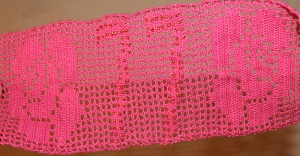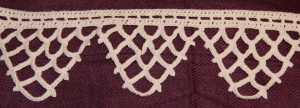Ta Da
February 27th, 2011
Finally, I’ve finished something.
The armband I designed for the 146+ Triangle Fire Memorial is ready to be mailed. I am very pleased with the way the roses came out. The 77 is harder to read than I’d like, so I outlined it in gold beads. That didn’t do very much either. Oh well. It’s there if you look closely. It’s also much easier to see when you hold the piece up to the light.
I didn’t sew it into a tube since filet is much less elastic than knitting, and I don’t know how big of an arm (or how bulky of a sweater) is going to sport this armband during the festivities on March 25. Instead, I made 5 little crochet loops on one edge, and a set of matching bobble buttons on the other. It’s too big for my little arm, and too small for my husband’s bulging bicep, so hopefully it’s just right.
So, in honor of Kate Leone, I am off to put this into an envelope and get it ready to mail to the organizers.
146 Plus
February 23rd, 2011
On March 25, 2011, New York City will commemorate the 100th anniversary of the deadly Triangle Shirtwaist Fire. 146 people, mostly young immigrant women, died in the sweatshop blaze, in a factory just north of Washington Square Park. In addition to remembering those who died, we’ll also honor the ongoing labor movements that their ordeal inspired.
If you’re not familiar with the story, Ruth Sergel, founder of Remember the Triangle Fire Coalition, will be speaking at the Victorian Society on March 8. I hope to attend myself. Then, on March 23, I’ll be speaking at the Merchant’s House on Hand-Sewing in the 1850s — 60 Years before the Triangle Shirtwaist Fire.
And last, but definitely not least, I (and my dear friend Zoh, among many others) are participating in an art project called 146+. We’ve each signed up to create an armband memorializing one of the victims. I chose 14 year-old Kate Leone, no. 77. She was Catholic, and unlike many of her fellow workers, born in the US.
The organizers of the event suggested that we knit the armbands, but also opened it up to other types of crafting. Since I can never do anything the easy way, I decided to make my armband in filet. Here’s the pattern I made:

And my progress so far.

I hope Kate would approve. I know a lot of 14 year old girls have already outgrown the whole pink thing, and she may have hated roses. But perhaps she would be tolerant considering the spirit in which it is worked.
Crochet Edging
January 17th, 2011
Here’s another edging, recommended for petticoats, from Peterson’s, 1855.

The pattern was remarkably well written and easy to follow, especially with the clear and accurate illustration. I still haven’t figured out how to gauge sizes on 19th-century cotton, but I’ve found some patterns for very fine tatted lace that call for no. 20 or 30 boar’s-head cotton, and directions for a coverlet calling for no. 10. So I am going to presume that, like today, the higher size numbers indicate finer thread. This pattern bears that out as well, asking no. 10 for a petticoat trim, but 16 or 20 for a child’s drawers.
I used what I had on hand to make up a sample — modern no. 16 cotton and a 1.3 mm hook. I don’t think I’d want to trim a petticoat with anything thicker than a modern no. 16; this is a pretty edging, but a bit on the stiff side already. It does seem strong, which was a frequently stated prerequisite for any undergarment trimming (they boiled their laundry, then it was wrung out, and finally put it through a mangle).
Best of all, even though it is worked over the full required length for the first four rows, it does work up relatively quickly. I wouldn’t mind making 100 or so inches of this to trim a petticoat. Someday.
Guipure Trimming
January 11th, 2011
Some women indulge themselves with expensive perfumes, dark chocolate, or spa visits. I subscribe to Accessible Archives. For a modest yearly fee, I can search every issue of Godey’s Lady’s Book ever published, not to mention lots of other great historical sources. The only down side is that since I find whatever I want immediately, I rarely bother to browse. And browsing is the best way to come across what you aren’t looking for.
Peterson’s Magazine, a Godey’s copycat, is searchable only through a very expensive academic database. So I read back issues, bound by the year, thanks to Google Books. I was browsing Peterson’s 1855 for chemise patterns when this showed up:

Given my recent obsession with petticoat trimming, I earmarked it for a trial run. And last week, I pulled out my crochet hook and a skein of cotton thread and whipped up 4 repeats of the pattern. Since the way thread and needle sizes are designated have changed since the 1850s, it’s always a bit of a guessing game to see which you should use. I had number 16 cotton on hand, and a size 10 (1.3 mm) crochet hook. The hook was a little small for the thread, but the next one up in my kit was far too big.
I really like the way this pattern looks. Though I would prefer a finer thread. Probably a great deal finer. Like most crochet edgings, it starts with a chain as long as you will require. There are only 7 rows, but at least two are quite involved. I think it would be slow going to trim a full petticoat, though not nearly so slow as Broderie Anglaise. And the effect would likely be stunning.
I had to fiddle with the pattern a little to make it work; thank heavens for the picture, which helped with intuitive leaps when the written directions became unclear. Some of the changes I made might not have been necessary though if I’d been using finer thread…and the end result would likely have been neater.
Oh, and if you are afflicted with curiosity, like me and the cat, real guipure is a heavy needlepoint lace in which the patterns are connected by thread ties or mesh. True lace, which was phenomenally expensive in the mid-19th century, was often imitated by crochet. One of the most noted examples of this is the legendary Irish crochet: “faux” laces created with great dexterity and sold by women to support their families during the Famine. Incidentally, by the end of the 19th century, exquisite Irish crochet was valued on its own merits, rather than its ability to mimic more expensive laces.
« Newer Posts



